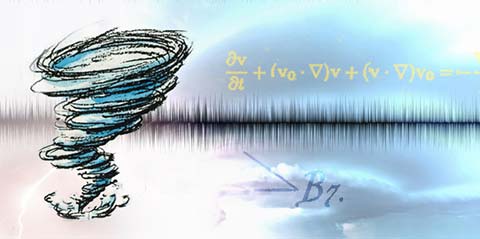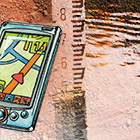


Roger Waxler
Many of the tools used to monitor hurricane and tornado activity are surprisingly basic—from the eyewitness sightings used to establish tornado landings to the disposable instruments dropped into hurricanes by daredevil flight crews.
To achieve the goal of more accurately pinpointing a tornado’s landing or measuring the intensity of a hurricane, researchers at the UM National Center for Physical Acoustics are developing sensors that gather data by listening to storms.
“Currently, radar gives us indications of conditions that lend themselves to tornado formation, but funnels hitting the ground are recorded by eyewitnesses,” said Roger Waxler, NCPA senior research scientist and research associate professor of physics and astronomy. “Infrasound sensors could provide a system that actually detects and reports where tornadoes are landing, rather than someone calling up frantically to say, ‘I’m on Highway 6, west of Pontotoc, and I see a funnel.’”

IFS 3000 Sensor
The sensors developed by NCPA measure infrasound, sound with frequencies below the threshold of human hearing. Funding from the National Oceanic and Atmospheric Administration allowed Waxler and his team to study infrasound signals related to tornadoes and hurricanes, and an agreement with the Tupelo-based Hyperion Technology Group Inc., has led to commercial development of the sensors.
For its initial tornado infrasound research, NCPA organized a tornado chase conducted by Hyperion. The group followed several tornadoes, setting out sensors, removing them and relocating them as the tornadoes progressed.
“Just by looking at tornadoes, people suspected they must produce low-frequency sounds,” said Waxler. “We were able to track the tornadoes beautifully from up to 60 miles with a large signal.”
For future tests, Waxler will leave sensors in place to monitor activity over an entire tornado season.
“We’re going to put arrays out and leave them, and pull the data periodically. With just one microphone, you often can’t distinguish the signals from background pressure fluctuations, so you need to set up several microphones to make sure you get a correlation and the signal between them.”
To observe hurricane signals, Waxler and his team placed sensors in national and state forests along the eastern seaboard from Florida to Connecticut. Tracking offshore hurricanes by infrasound may make it possible to monitor the storms more regularly than current methods, which allow data to be collected approximately every six hours with significant risk to air crews. Infrasound monitoring could potentially provide continuous half-hour updates.
“The hurricane signal has been known to exist for about a hundred years,” Waxler said. “If you look at the spectrum of atmospheric noise, it’s a hump of radiated sound that’s being picked up from huge distances. That hump has been identified as coming from colliding ocean waves. We can detect this activity in the Atlantic from as far away as New Mexico.”
NCPA’s sensors have a host of applications beyond the ability to measure weather events. The primary focus of Waxler’s research is aimed at the detection of clandestine nuclear weapon tests. In that research, Waxler and his team have traveled around the world to capture the infrasound signals of large chemical explosions designed to act as nuclear weapon surrogates.

Walt Chambliss
The sensors’ potential applications, both military and non-military, led the UM Division of Technology Management to negotiate a license agreement with Hyperion to commercialize the group’s infrasound sensor technologies. Hyperion has released three different series of the sensors.
The partnership is a win-win for Hyperion and NCPA, Waxler said.
“These sensors are the state-of-the-art infrasound microphone right now,” he said, explaining the motivation for commercialization. “But we didn’t want to be a company—we like doing research—so partnering with Hyperion to commercialize the sensors was a logical next step.”
“Hyperion has been successful, in part, because they are an innovative company that understands the value of university research,” said Walt Chambliss, director of UM’s Division of Technology Management. “The infrasound sensors developed by the NCPA infrasound group are an excellent example of an advanced technology discovered, developed and manufactured in Mississippi.”



